Menus
- Back to the Future
- Suzuki GT 750: dazzling in shape?
- Enthusiastic anniversary trip two and a half years ago
- Suzuki GS 750 heralds a change of pace
- Power at low speeds is enough to swim along
- GS 750 makes the more balanced impression
- Technical data Suzuki GT 750 / GS 750
- Model history
- Things worth knowing about the Suzuki GT 750
- Restoration of a Suzuki GT 750
- The crankshaft is the engine’s Achilles heel
- The question of costs
- Conclusion
- Interesting facts about the Suzuki GS 750
- Tips for buying a Suzuki GS 750
- Conversion to contactless ignition is easy
- Reproductions of the seat covers can be found in Great Britain
- Opinions of the owners
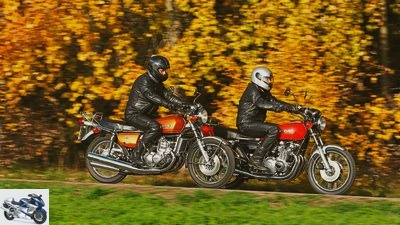
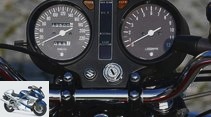
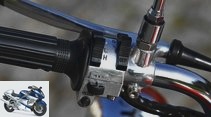
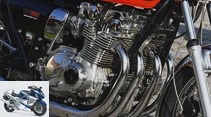
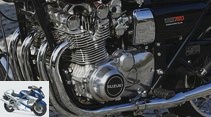
37 photos
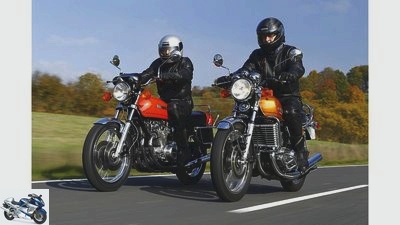
www.factstudio.de
1/37
With the GT 750 and GS 750, Suzuki had two attractive alternatives in its range, …
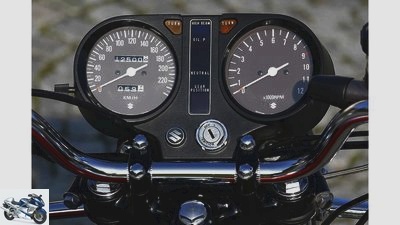
www.factstudio.de
2/37
The cockpit turned out to be very clear.
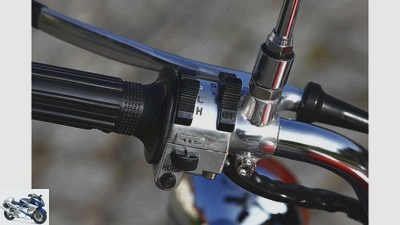
www.factstudio.de
3/37
Polished fittings on early GS.
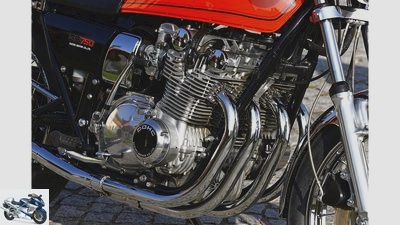
www.factstudio.de
4/37
A symmetrical structure, lush cooling fins and the chrome-plated end caps on the valve cover…
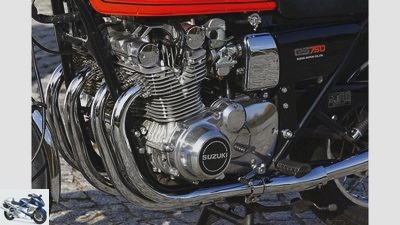
www.factstudio.de
5/37
…are the characteristic features of the GS four-stroke.
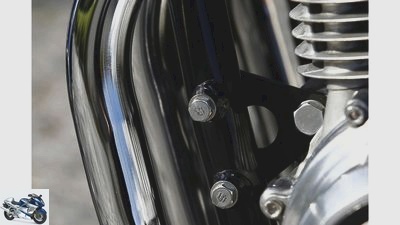
www.factstudio.de
6/37
Suzuki GS 750.
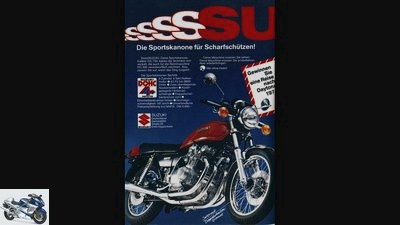
www.factstudio.de
7/37
This GS 750 advertisement appeared in MOTORRAD on April 20, 1977 – 13 days after the fatal shots at Federal Prosecutor General Siegfried Buback and his two companions, which were fired from a Suzuki GS 750 by two RAF members who have not yet been identified. Although the agitators at the advertising agency had formulated the aggressive text long beforehand, the public and media outrage at the time was enormous.
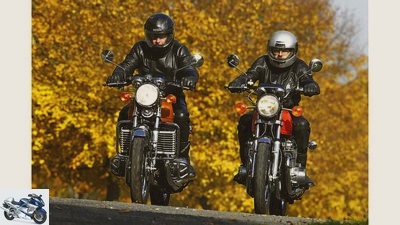
www.factstudio.de
8/37
Broadly positioned: The GT 750 and GS 750 were initially offered in parallel in the Suzuki model range.

www.factstudio.de
9/37
The two-stroke engine is built much more expansively.
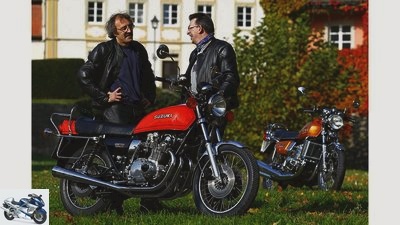
www.factstudio.de
10/37
The two Suzuki lovers Frank Lutz and Andreas Issel.
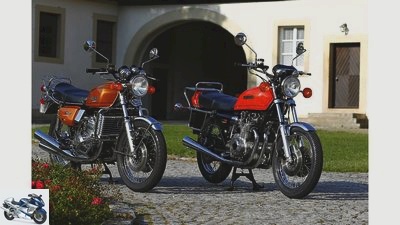
www.factstudio.de
11/37
Suzuki GT 750 and GS 750.
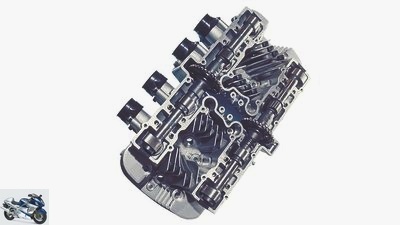
www.factstudio.de
12/37
Two overhead camshafts operate the two valves per cylinder via bucket tappets.
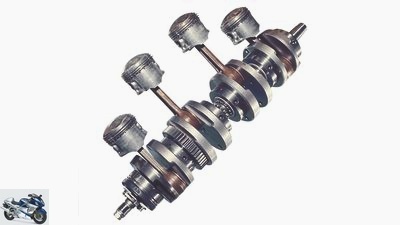
www.factstudio.de
13/37
The crankshaft of the GS 750 rotates in five rollers and …
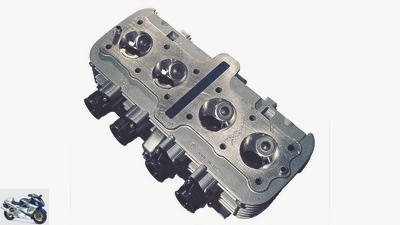
www.factstudio.de
14/37
… a ball bearing, the connecting rod feet run on needle bearings.
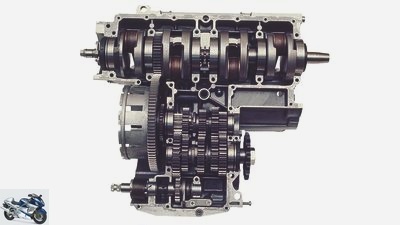
www.factstudio.de
15/37
The torque is transmitted to the multi-plate oil bath clutch via a straight-toothed primary drive.
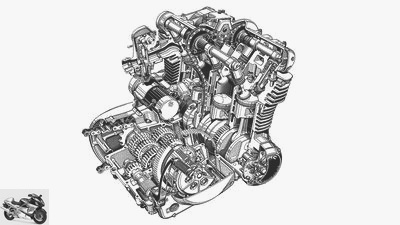
www.factstudio.de
16/37
The cylinders, cast from an aluminum alloy, have shrink-fit liners.
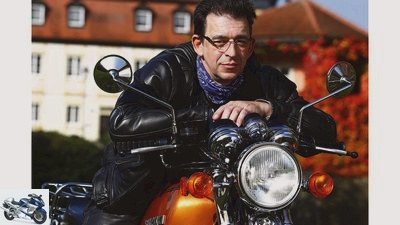
www.factstudio.de
17/37
For Andreas Issel, the Suzuki GT 750 is a childhood dream.
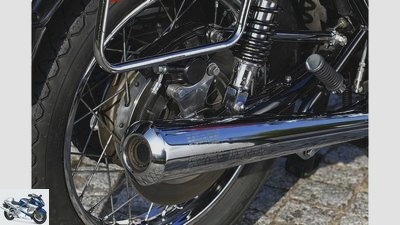
www.factstudio.de
18/37
Suzuki GS 750.
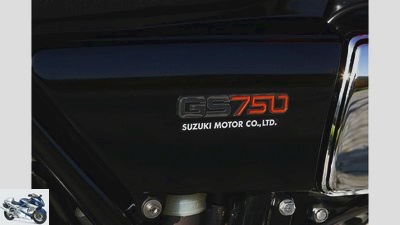
www.factstudio.de
19/37
Suzuki GS 750.
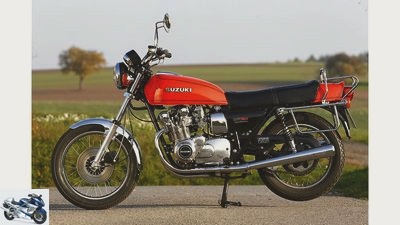
www.factstudio.de
20/37
The few childhood diseases that existed were eliminated on the guarantee route.
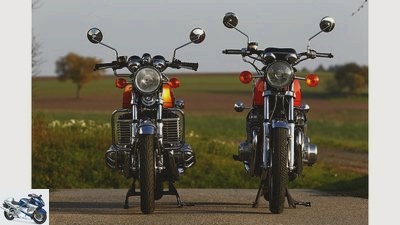
www.factstudio.de
21/37
… whose characters could hardly have been more different.
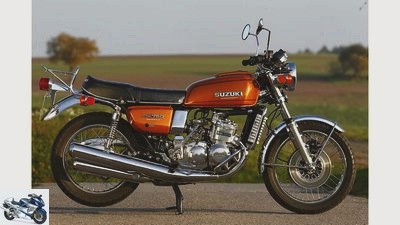
www.factstudio.de
22/37
The Suzuki GT 750 was first presented at the Tokyo Motor Show in 1970.
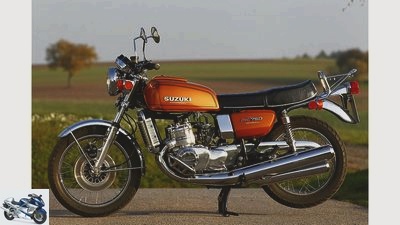
www.factstudio.de
23/37
From 1972 it was also available in Europe.
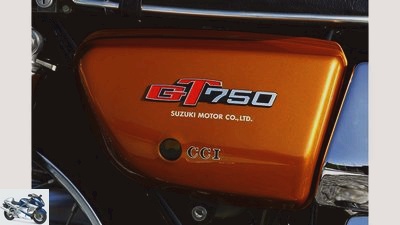
www.factstudio.de
24/37
Suzuki GT 750.
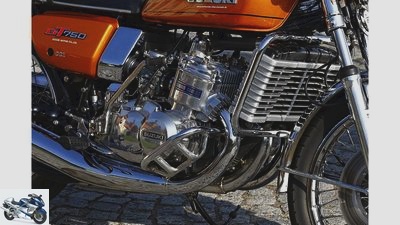
www.factstudio.de
25/37
Suzuki GT 750.
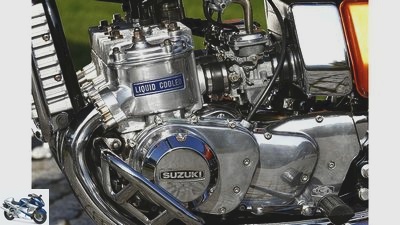
www.factstudio.de
26/37
Four mufflers for three cylinders – a GT 750 offers the eye many highlights.
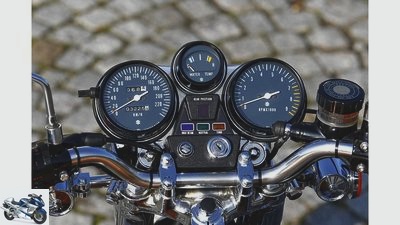
www.factstudio.de
27/37
The cockpit is equipped with a gear indicator.
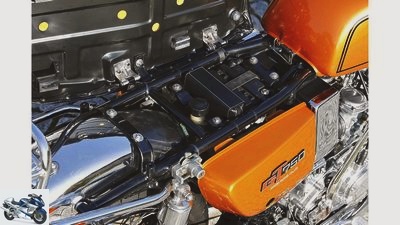
www.factstudio.de
28/37
Foldable bench with oil filler neck for separate lubrication.
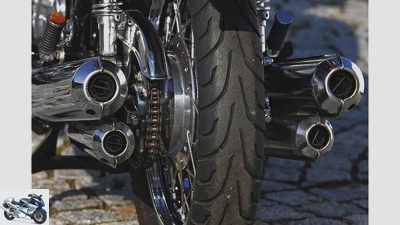
www.factstudio.de
29/37
Suzuki GT 750.
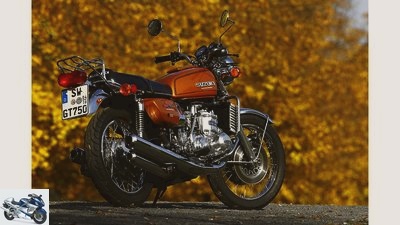
www.factstudio.de
30/37
Suzuki GT 750.
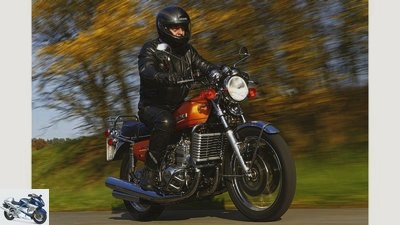
www.factstudio.de
31/37
Suzuki GT 750.
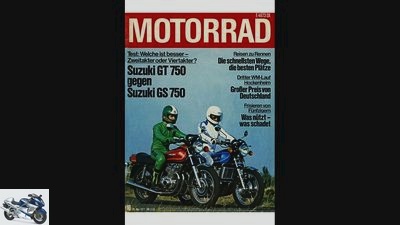
www.factstudio.de
32/37
As a supplement to the comparison test with the GT 750, a standard Suzuki GS 750 – except for the equipment with half-shell, clip-on handlebars and Koni shock absorbers – was thrashed 1000 kilometers through the oval of the Contidrom by the MOTORRAD team at full throttle.
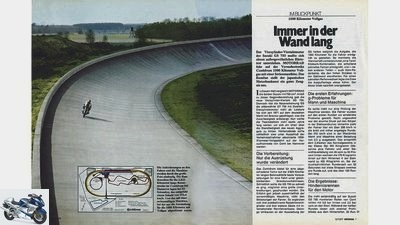
www.factstudio.de
33/37
A merciless material test with an average speed of 195.4 km / h. However, Suzuki’s first four-stroke four-cylinder completed it with flying colors, as the subsequent dismantling of the engine showed.
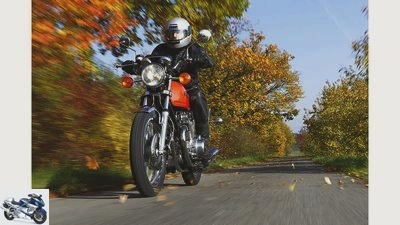
www.factstudio.de
34/37
Suzuki GS 750.
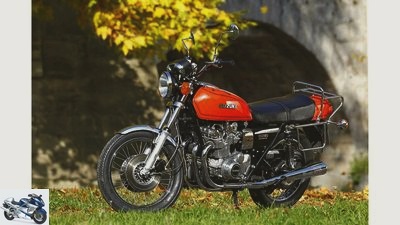
www.factstudio.de
35/37
The simple design shows off the beautiful four-stroke four-cylinder particularly well.
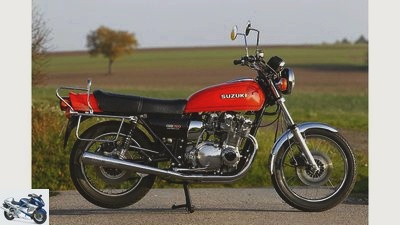
www.factstudio.de
36/37
It came on the market in 1976 as a mature and reliable motorcycle.
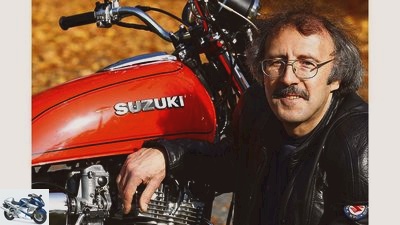
www.factstudio.de
37/37
Frank Lutz thinks his GS 750 is too good for everyday use.
On the move with Suzuki GT 750 and Suzuki GS 750
Back to the Future
Content of
40 years ago, Suzuki was the last Japanese manufacturer to present a modern four-stroke machine. On the occasion of the anniversary, we took the Suzuki GS 750 on a little journey through time, accompanied by its two-stroke sister, the Suzuki GT 750. And we look back on the time when Suzuki set the course for the future.
A lot of media coverage when a new product is launched is usually exactly what a manufacturer wants. In the case of the Suzuki GIn S 750, however, the shot backfired. Because the advertisers listed heavy artillery in their advertisement (MOTORRAD 8/1977) by naming the brand’s new four-stroke hopeful as a “sports cannon for snipers” in “caliber 750”.
Buy complete article
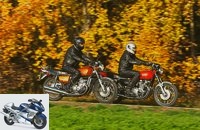
On the move with Suzuki GT 750 and Suzuki GS 750
Back to the Future
Frank Lutz owns almost all of the members of the GS family
The media spectacle surrounding the Suzuki GS 750 has long been history, and the German autumn 2015 was a very peaceful one. At least in beautiful Franconia, where I meet Andreas “Belmondo” Issel and Frank Lutz. Two Suzuki lovers who want to tell me a few bars about the 750s from the third largest Japanese motorcycle manufacturer. Andreas is satisfied with the two strokes of his beautifully restored Suzuki GT 750.
Frank also has a sympathy for the “water buffalo”, but has come to appreciate and love the problem-freeness and reliability of the four-stroke Suzuki. So much so that his garage accommodates almost all members of the GS family, as loyal Classic readers know (see issues 6/2014 and 8/2014).
Suzuki GT 750: dazzling in shape?
They will surely recognize Andreas too. After the story with the GT 550 (issue 6/2014), he is now looking forward to “great photos of the Suzuki GT 750”, which he has put together in the way he always dreamed of. It is an A-model from 1976. “It had all the chrome trim for the last time, and I also like the slimmer tank and the stretched line from 1974 onwards.” But only in the “Aztec Gold” color from 1973. “I find it the most beautiful, that’s why it had to be this finish, even if originality fetishists turn up their noses because of it! “
Well, I have nothing to complain about. On the contrary, Andreas ‘love of detail and perfection when rebuilding his Suzuki GT 750 impresses me deeply. Many GT enthusiasts seem to fare the same. Which is why the trained engine reconditioner has meanwhile turned his hobby into a profession. In his workshop in Schweinfurt he now builds such beautiful two-stroke Suzuki for customers – some even come from overseas. And documents his work in detail on his informative and readable homepage on the Internet (www.belmondos-bikeschmiede.de). So everything is fine?
www.factstudio.de
Test drive despite the ailing heart of the buffalo.
Unfortunately, no. After the obligatory photo drives, I notice Andreas ‘pained expression on his face as he hands me the ignition key. “I just heard such an ugly screech, could it be the crankshaft.” Bearing damage? “Possible, but it should be enough for a short lap, I have to completely overhaul the engine anyway”, Andreas encourages the depressed author to take a test drive. A grand gesture!
I swing on the chest of drawers and drive off – with a bit of a lump in my throat, as you can probably imagine. However, I quickly realize that the Ox’s ailing heart does not allow any reasonable statements. As a benchmark for the more modern four-stroke sister, Andreas ‘Suzuki GT 750 in this battered condition is certainly not suitable. Tormenting any further makes no sense, the water-cooled three-cylinder vibrates unpleasantly, progresses rather cautiously and jerks violently in push mode – in short, the Suzuki behaves very differently than I remember it!
Enthusiastic anniversary trip two and a half years ago
Around two and a half years earlier, the water buffalo was very positively anchored in my memory. Although I’m not necessarily one of those two-stroke affine contemporaries, I was really enthusiastic about the Suzuki GT 750 – also a model with 63 hp – on our anniversary trip (issue 3/2013). What was mainly due to the incredibly smooth running and brawny three-cylinder, which pushed me out of the turns of the Col de l‘Espigoulier in the south of France just above idle with a bassy intake noise and singing two-stroke saws.
An emotional experience that has burned itself into my hard drive forever, even though you need strength on narrow country roads with many alternating curves to keep the Suzuki GT 750 on course. Yes, the two-stroke Suzi doesn’t have much to do with sport, if only because of the lack of lean angle and the not particularly powerful brakes, as Andreas ‘copy showed me again. But never mind, the typical buffalo driver of today has long rejected his horns. The sovereign character of a GT 750 is best enjoyed without hectic anyway, as is the impressive running culture.
Suzuki GS 750 heralds a change of pace
On the other hand, the four-stroke four-cylinder Suzuki GS 750 tingles more noticeably in the handlebars and footrests than in a healthy three-cylinder buffalo heart. The reason is the roller-bearing crank mechanism. Not least because of the fact that the concept of the four-stroke series was a little grayed out at the start, Suzuki preferred this to the sliding bearings, which promised smoother running, in the GS series. Because the Suzuki engineers were not really as inactive as it appeared to be with the four-stroke engine. Tests with multi-cylinder engines were already underway at the end of the 1960s. Ultimately, however, they backed the wrong horse in Hamamatsu and brought the RE 5 rotary machine in 1972, which flopped.
So it was left to the Suzuki GS 750 to ring in the clock change at Suzuki from 1976 and to set the course for the future-proof four-stroke technology. As a late entry, Suzuki could not allow itself any weaknesses. With its solid technology, the GS 750 – like the GS 400 and GS 550 as further members of the new four-stroke family – was distinguished from the start as a well-engineered motorcycle.
www.factstudio.de
With its solid technology, the Suzuki GS 750 distinguished itself as a mature motorcycle.
Frank Lutz also confirms this: “The construction of the four-stroke engines is extremely robust and very stable.” Franconians should know, after all, he has been working with the GS models for over 30 years. His Suzuki GS 750 in “Pure Orange” is a very special one. It was already approved in Germany in August 1976, although the official presentation did not take place until the following autumn at the IFMA in Cologne. “Based on the chassis number, it must be a pre-production copy, maybe even a homologation machine that came from the importer’s sphere of influence,” suspects Frank.
He bought the completely original GS at the end of the 1990s with only 9000 kilometers on the clock. Although it had some damage to the floor, it showed excellent substance overall. Frank was able to restore the GS to its new condition with little effort. However, compared to the Suzuki GT 750, it gives me the impression of functional objectivity. With the Suzuki GS 750, the more clocks go hand in hand with less glamorous opulence.
In return, the restrained design around it brings out the beautifully constructed and generously ribbed four-stroke engine particularly well. Technically, however, the dohc four-cylinder did not offer any sensations 40 years ago. Still, I’m a little nervous when I swing myself into the saddle of Frank’s best piece. Are the 12,500 kilometers correct? Frank nods. “It’s too good for me in everyday life.” Speaks and gives me an encouraging pat on the shoulder as I release the clutch – thank you again!
Power at low speeds is enough to swim along
Before I give the Kurzhuber my spurs, I take it easy to get warm with the GS. Compared to the very comfortable posture on the Suzuki GT 750, the high handlebars and the pegs placed quite far forward force me into a somewhat passive seating position on the four-stroke 750. I can live with that, however, because the foursome beneath me works exactly the way you want it to in everyday life. The acoustically restrained two-valve engine pulls in smoothly, even at 50 km / h in fifth gear of the gearbox, which can be shifted more precisely than the two-stroke sister. The power at low speeds is enough to swim along in traffic. But nothing more.
The Suzuki GS 750 cannot offer pressure in the lower rev range, like the Suzuki GT 750, its four-cylinder needs higher speeds. There is a decent start at 5000 rpm, from 6500 rpm a second wind willingly lets the four-cylinder hit the red area at the 9500 mark. So there is temperament. The vehement thrust of the two-stroke triplet is more vividly remembered, if I’m honest. But that can also be due to the fact that two-stroke engines generally offer the higher entertainment value for me, because I have much less experience with it than with four-cylinder four-stroke engines.
GS 750 makes the more balanced impression
You shouldn’t misunderstand that the Suzuki GS 750 seems less spectacular to me. Personal preferences are decisive when it comes to which character suits you better: that of the Suzuki GT 750 with the powerful thump – or is it the lively nature of the revving GS? If I had the choice, I would probably end up going for the more modern four-stroke. Not only because of the stable and reliable technology, but also because of the pleasantly neutral and stable driving behavior.
Changing lean angles is easier with the Suzuki GS 750, thanks to better damping spring elements, it also ironed over wavy sections more smoothly. The brakes also bite better, which is why the GS 750 makes a more harmonious and balanced impression in terms of driving dynamics. But maybe that was not enough. Or too unspectacular. Compared to other greats in the motorcycle scene, the GS 750 has so far lacked the appreciation that other milestones are accorded. Frank Lutz definitely counts Suzuki’s first four-stroke four. However, even in the anniversary year, media interest in the GS 750 will probably be much less than it was back in April 1977.
Technical data Suzuki GT 750 / GS 750
www.factstudio.de
Suzuki GT 750 and Suzuki GS 750.
Technical data Suzuki GT 750 (Type GT750A)
- engine: Liquid-cooled three-cylinder two-stroke in-line engine, slot-controlled, separate lubrication with load and speed-dependent oil pump, displacement 739 cm³, output 46.3 kW (63 HP) at 6500 rpm
- Power transmission: Multi-disc oil bath clutch, five-speed gearbox, chain drive
- landing gear: Double loop frame made of tubular steel, telescopic fork, Ø 35 mm, two-arm swing arm made of tubular steel, two spring struts, wire-spoke wheels with chrome-plated steel rims, tires 3.25 H 19 at the front, 4.00 H 18 at the rear, double disc brake at the front, Ø 292 mm, single-piston floating calipers, disc brake at the rear
- mass and weight: Wheelbase 1455 mm, weight with a full tank 251 kg
- Top speed: 191 km / h
- price 1977: 6900 marks
Technical data Suzuki GS 750 (Type GS750DB)
- engine: Air-cooled four-cylinder four-stroke in-line engine, two overhead camshafts, two valves per cylinder, actuated via bucket tappets, displacement 748 cm³, output 46.4 kW (63 hp) at 8800 rpm
- Power transmission: Multi-disc oil bath clutch, five-speed gearbox, chain drive
- landing gear: Double loop frame made of tubular steel, telescopic fork, Ø 35 mm, two-arm swing arm made of tubular steel, two spring struts, wire-spoke wheels with chrome-plated steel rims, tires 3.25 H 19 at the front, 4.00 H 18 at the rear, double disc brake at the front, Ø 275 mm, two-piston fixed calipers, disc brake at the rear
- mass and weight: Wheelbase 1490 mm, weight with full tank 253 kg
- Top speed: 195 km / h
- price 1977: 6990 marks
Model history
www.factstudio.de
Broadly positioned: The GT 750 and GS 750 were initially offered in parallel in the Suzuki model range.
Model history Suzuki GT 750
Construction year
Type
1971/1972
Type GT750J (52 HP):
Double duplex brake in the front wheel, front mudguard with two struts, bellows on the fork, exhaust system with interference pipes and black end caps, radiator with fairing and fan, slide carburetor, seat cover with diamond pattern and imprint “Suzuki GT 750”, taillight with two bulbs, headlight and holder painted in tank color. Tank decor in white. Side cover with lettering “water cooled 750” and indicated ventilation grilles (chassis numbers GT750-10001 to 31252).
Colours: Candy Lavender, Candy Yellow Ocher, Candy Jackal Blue
1973
Type GT750K (52 HP):
Double disc brake at the front, chrome-plated radiator cover on the side, tank decor in black (chassis numbers GT750-31253 to 40246).
Colours: Pearl Blue, Candy Gold, Black, Pure White, Dark Green
1974
Type GT750L (52 HP):
Telescopic fork without bellows, grille made of plastic, constant pressure instead of slide valve, new air filter housing with side access to the air filter, new side cover, rear light with a light bulb, lamp and holder chrome-plated, exhaust system with interference pipes without black end caps, cylinder labeled “liquid cooled”, newer Seat cover with horizontal ovals and “Suzuki” lettering, omission of the radiator fan, tank decoration with thin black lines (chassis numbers GT750-40247 to 52822).
Colours: Flake Blue, Flake Orange, Silver Metallic, Pearl Metallic
1975
Type GT750M (63 HP):
Performance increase through exhaust without interference pipes and larger cross-section as well as modified timing, tank decor in silver (chassis numbers GT750-52823 to 61728).
Colours: Jewel Gray Metallic, Candy Gypsy Red, Candy Gold, Silver Metallic
1976
Type GT750A (63 HP):
New tank with large sheet metal flap, tank decor with thin black lines (chassis numbers GT750-61729 to 75738).
Colours: Maui Blue Metallic, Flake Orange, Candy Gypsy Red, Candy Gold, Jewel Gray Metallic, Silver Metallic, Pearl Metallic
1977
Type GT750B (63 HP):
Front fender and indicators from the GS series (in some countries also rear light), lamp, holder and side cover in black silk matt (chassis numbers GT750-75739 to approx. 80508).
Colours: Maui Blue Metallic, Candy Gypsy Red, Black
Model history Suzuki GS 750
Construction year
Type
1976/77
Type GS750B:
Single front brake disc, Ø 295 mm, two-part, riveted, thickness 6.7 mm (chassis numbers GS750-0001 to 32603).
Type GS750DB:
Double disc brake, front, Ø 275 mm, two-part, riveted, thickness 6.7 mm, rear brake disc Ø 295 mm, two-part, riveted, thickness 6.7 mm. Seat cover with vertical stripes, pinion cover with rubber pads, handlebar switch made of aluminum, emblems in chrome, choke on the carburettors, wiring harness with a fuse, seven-segment gear indicator (chassis numbers GS750D-10001 to 20096).
Colours: Black, Candy Gypsy Red, Pure Orange, Strato Blue, tank decor with thin lines
1978
Type GS750C:
Single front brake disc, Ø 295 mm, one-piece, thickness 6 mm (chassis numbers GS750-32604 to 45133).
Types GS750DC / EC:
Double disc brake front, Ø 275 mm, one-piece, thickness 6 mm, rear brake disc, Ø 275 mm, two-piece, riveted, thickness 6.7 mm. Changed front hub (uniform for all GS), bench with aluminum trim, handlebar switch made of plastic, E-model with cast wheels (chassis numbers GS750D-20097 to 22016 and GS750E-10001 to 34214).
Colours: Candy Florida Blue, Black, Scarlett Medium, tank decor with thin lines
1979
Types GS750N / DN / EN:
Wider tank decor, foldable driver footrests, thicker passenger footrests, gear indicator with individual lamps, gold-colored emblems, seat cover with rectangular pattern and aluminum trim, choke in the steering head, wiring harness with four fuses, combined regulator / rectifier unit, additional M6 screw at the front of the timing chain slot for better sealing. In 1980 this model was still offered as type GS750ET in some markets. Chassis numbers of GS750N: from GS750-45134, GS750DN: from GS750D-22017, GS750EN: from GS750E-34215.
Colours: Marble Canadian Blue, Marble Pure Red, Candy Lovelock Maroon, Candy Caribean Green, Black
Type GS750L:
Soft chopper with modified engine characteristics, not to be confused with the GSX 750 L with four-valve engine and the same optics. No official import to Germany (chassis numbers from GS750-700001).
Colours: Black, Marble Ontario
Type GS70G:
Cardan variant for the Japanese market, modified clutch actuation. Offered in Germany with a 67 mm bore as GS 850 G..
Colours: Black, Candy Imperial Maroon, Marble Ontario Blue
Things worth knowing about the Suzuki GT 750
www.factstudio.de
The Suzuki GT 750 was first presented at the Tokyo Motor Show in 1970.
The Suzuki GT 750 was first presented at the Tokyo Motor Show in 1970 and went on sale in 1971. From spring 1972 it was also available in Europe. The “water buffalo” was produced until 1977. In addition to the water jacket and large radiator, the exhaust system was one of the characteristic features of the GT 750, which was based heavily on the Honda CB 750 Four – the three-cylinder two-stroke engine had four silencers throughout the construction period . That may once have been important at the regulars’ tables.
Technically, this was not a good solution, because the chamber volume of the two middle pots did not match that of the outer pots. To compensate for this, the middle carburetor was sprayed differently. But even with that, Suzuki never really got the problem with the different combustion under control. With the 3-in-3 solution, Kawasaki had clear advantages in their own three-cylinder two-stroke engines – and in direct comparison they always had more power than the Suzuki GT 750, not just the 750s. Nevertheless, the water buffalo with its gentle but emphatic nature has gathered a large fan base today.
Restoration of a Suzuki GT 750
Good machines are rare these days and mostly in steady hands. The majority of the Suzuki GT 750 offered are imports from the USA, which often consist of a colorful mix of parts from different years of construction. This creates a lot of problems during a restoration. A decisive criterion for the reconstruction of a GT 750 is the original exhaust system, which is usually rusted through or completely rotten. However, there are hardly any more flawless systems. If one is offered, then only for expensive money.
But the replica of the English company Delkevic (www.delkevic.co.uk) is also an expensive pleasure. So pay particular attention when buying! Otherwise nothing stands in the way of a restoration, technical parts are still available without problems and at reasonable prices, mostly directly from Japan. Pistons come in three oversizes (in Japan even seven oversizes!). However, whether it is possible to drill to an excess depends on the cast sleeves of the cylinders. They weren’t always 100 percent centered. Then the wall can become too thin for oversize holes. The problem is that the liners cannot be replaced because the cylinders were cast around the liners.
The crankshaft is the engine’s Achilles heel
The Achilles heel of the GT engine, which otherwise hardly causes any problems, is the crankshaft. After decades, the crankshaft oil seals are often hardened and develop hairline cracks. Then the only thing that helps with all Suzuki engines of the GT series is an extensive overhaul of the shaft by a specialist. In my opinion, the best for the shafts of the Suzuki GT 750 is Bernd Braun (www.crankup.de). The BD 40 constant pressure carburettor installed from 1974 (from GT750L) onwards often reveal further problems.
Worn nozzle assemblies and throttle valves make many copies of the Suzuki GT 750 run very unevenly, up to and including bad jerking when overrun. An overhaul of the carburetor battery is then inevitable. Almost all of the carburetor parts are still available, but can be difficult to find.
The question of costs
If a Suzuki GT 750 is still comparatively affordable in terms of purchase, a complete restoration is quite expensive.
The optical refurbishment is particularly complex, especially with one of the popular GT750A with its many chrome parts. That is why many GT750B are being converted to an A-model. Then a good restoration can cost 10,000 euros, and even 15,000 euros are not uncommon.
Conclusion
My conclusion: For me, the Suzuki GT 750 is one of the most beautiful classics that Japan has ever produced. Despite the technical problems with the four-pipe exhaust system based on the Honda CB 750 Four, I think the water buffalo is unique. With their baroque shapes, I don’t really like the early J and K models. From 1974, however, the design corresponds exactly to my ideas of a timelessly beautiful machine. In addition, the technology was fully developed from the M model. My clear favorite is the A. It is also clear that the market value of a GT 750 does not reach the level that this Suzuki would have deserved.
Not least because of the offers that are now almost exclusively made up of different model series. Complete originals of a series are rare and also very difficult to recognize. Still, rebuilding a Suzuki GT 750 is worthwhile if the starting point is right. Because a GT 750 is always a crowd puller and is particularly admired and raved about by the “over 50” generation. With one of the not so rare “blenders”, however, a restoration can quickly turn into a dime-grave and the dream project can mutate into a nightmare. Andreas Issel
Interesting facts about the Suzuki GS 750
www.factstudio.de
It came on the market in 1976 as a mature and reliable motorcycle.
The Suzuki GS 750 came onto the market in 1976 as a mature and reliable motorcycle. The few teething troubles, such as leaky intake manifolds or oily head gaskets, were eliminated on the guarantee route. Now and then there were still problems with oil control rings losing tension and too soft valve guides.
Tips for buying a Suzuki GS 750
Most Suzuki GS 750 have a very high mileage, but this usually doesn’t cause any problems. The crankshaft drive and transmission, which is derived directly from the Suzuki GT 750, are considered to be almost indestructible. If necessary, valves and guides are readily available, as well as pistons in the first oversize. But not those in the second excess. Alternatively, you can switch to the cylinder, piston and head of the GS 850 – that even brings about 15 hp more!
For engines from 1976 to 1978, minor reworking is required on the crankcase; the conversion is documented on the Internet. A common problem with all GS are leaky shaft seals, often on the timing chain tensioner or occasionally on the ignition system. However, all shaft seals can be changed from the outside without dismantling the motor.
Conversion to contactless ignition is easy
The conversion to the contactless ignition of the later GS / GSX models is easy and recommendable, since the quality of the breaker contacts has decreased significantly. Wear parts are still readily available. There were four different carburettors, identifications 45011, 45012, 45013 and 45060 with different nozzle configurations. Do not mix these together! Rust is an issue especially on the original exhaust system. There is always water at the outlet when the machine gets wet and the underside rusts through from the inside out. The exhaust system has a small ventilation hole at the end and a drainage hole between the manifold and the muffler at the lowest point, both should be free. If the original exhaust is intact, occasionally flood the system with penetrating oil through the ventilation hole until it comes out again at the lowest point. Condensation is also rinsed out in this way.
The frame, which is not primed at the factory, also has several neuralgic points. The right frame reinforcement, which supports the motor and swing arm, can even rust through from the inside out! This applies to models from 1978 onwards. The gusset plate was not welded through on the top of some frames, so water can penetrate here. Especially when driving without an air filter box that covers the area. Rotten frame tubes can also be the cause of inexplicable swing arm play. Also make sure that the two M8 threads of the frame cross brace under the steering head are closed, otherwise water will penetrate the frame when driving in the rain. A good indicator of the past life of a Suzuki GS 750 is the chrome-plated cover on the lower triple clamp, the inside of which has hardly been preserved at the factory. If there is a lot of rust when looking with the mirror, the machine was often damp.
Reproductions of the seat covers can be found in Great Britain
Otherwise the chassis of the Suzuki GS 750 is problem-free, it can also keep up with more modern designs. Maybe there’s something to the rumor that Fritz Roth sent a Moto Guzzi frame to Hamamatsu for inspection. Still recommendable: a conversion to tapered roller bearings in the steering head and a check of the needle bearings of the swing arm as well as the conversion to modern tires and struts. Beware of a rotten exhaust: there are no longer any original systems. And every accessory exhaust costs performance, 4-in-1 systems make access to the oil filter difficult. The bench is identical to the GS 550. The problem here is that the base plates are rusted away and only given a touch of varnish at the factory. There are replicas today, but the quality does not come close to the original. High-quality reproductions of the seat covers can be found in Great Britain.
The speedometer, tachometer and rear bumper are identical to the GS 550 parts; they are widely available used. The front fender, which is identical to the GS 550, is even still available as a new part from Suzuki. The starter and alternator also come from the GS construction kit, they usually do not cause any problems. Let’s get to the prices: This shows that the Suzuki GS 750 was one of the most underrated motorcycles of the 1970s, which is reflected overall in a price level that is far from being on the level of the competition at the time. About 3600 GS were sold in Germany, a good part of which should still exist. However, good original machines are extremely rare. Wild conversions predominate, in which the original condition is difficult to restore, since many original add-on parts can hardly be found even used in good condition.
Opinions of the owners
www.factstudio.de
For Andreas Issel, the water buffalo is the dream of young people.
Andreas Issel (owner of the Suzuki GT 750)
For me, Suzuki’s water buffalo is the dream of my youth. This is what a big, heavy motorcycle should look like. Technically, too, the water-cooled two-stroke engine is a fascinating engine for me. And it’s beautiful too, with its symmetrical design and the many polished or chrome-plated attachments and engine covers. If I had had the choice between Suzuki’s two 750s and the money, my decision would have been clearly in favor of the Suzuki GT 750. Even knowing that the four-stroke GS is the more modern and ultimately probably also the better motorcycle.
www.factstudio.de
Frank Lutz’s Suzuki GS 750 is too good for everyday use.
Frank Lutz (owner of the Suzuki GS 750)
Actually, my wife is the reason that I got this Suzuki GS 750. After 15 years as a passenger on the 400, which for me was the most visually beautiful of all GS models, the complaints about the short and hard seat became louder and louder. So I decided on the second most beautiful from the GS family, the 750. It was clear that it had to be a Suzuki. However, this perfect GS 750 is too good for me in everyday life. Such original copies are really rare today, only about 3600 pieces were sold. That’s why I bought a couple of GS 750s and a lot of parts. But I’m still missing one in “Strato Blue”…
Related articles
-
On the move with the Suzuki GS 550 E and Suzuki GT 550
30th photos www. 1/30 In the mid-1970s, Suzuki was pretty late in setting the course for the future. It was not until 1976 that…
-
Johann Test Suzuki Bandit 650 ABS Bandit reissue An institution like the Suzuki Bandit 650 cannot be written off from a recently launched Yamaha XJ6….
-
Two-stroke Benelli 250 2C, Maico MD 250 and Suzuki GT 250
Wolf 48 pictures Wolf 1/48 Suzuki GT 250. Wolf 2/48 The once praised disc brake now looks a bit dull and toothless. Wolf 3/48 The brave …
-
News from BMW, Suzuki, KTM, Triumph and Ducati
Suzuki innovations from BMW, Suzuki, KTM, Triumph and Ducati King without shaft Who still needs vertical shafts? The recently presented BMW HP2 Sport shows off …
-
On the move with the Suzuki GS 400
18th photos 1/18 1989: Drilled to 487 cm³, the GS 500 E starts with 46 HP. Its two-valve engine is also based on that of the GS…
-
Jahn 13 photos Suzuki 1/13 In black and yellow, the Gladius can compete with the Honda Hornet. Suzuki 2/13 The low seat belt was specially tailored to…
-
Jahn 13 photos Suzuki 1/13 In black and yellow, the Gladius can compete with the Honda Hornet. Suzuki 2/13 The low seat belt was specially tailored to…
-
Suzuki Gladius and Kawasaki ER-6n in comparison test
Blacksmith 16 photos Jahn 1/16 Suzuki Gladius and Kawasaki ER-6n in comparison test. Which of the 650 twin-cylinder has the edge in the end? Jahn 2/16…
-
Suzuki innovations Grand with fours Diversity is the key. With four new models – from hyper bikes to travel scooters – Suzuki is doing everything in its…
-
Honda, Yamaha, Suzuki, Kawasaki and KTM
Manufacturer 16 pictures 1/16 2/16 3/16 4/16 5/16 6/16 7/16 8/16 9/16 10/16 11/16 12/16 13/16 14/16 15/16 16 / 16 Honda, Yamaha, Suzuki, Kawasaki and KTM The …